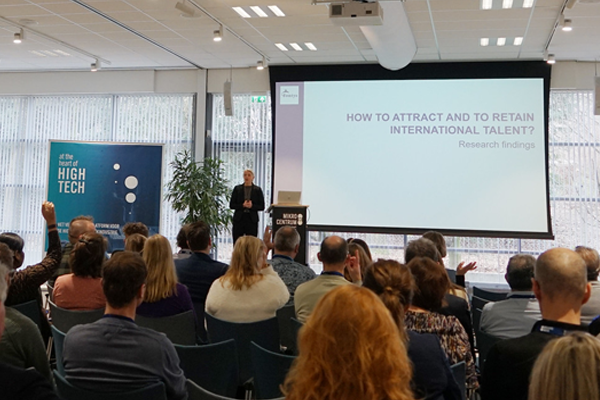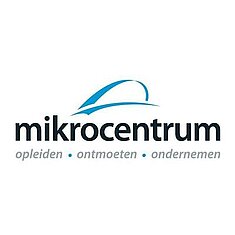Recap High Tech HR Meet-up: About attracting, captivating and retaining tech talent

A warm welcome. An (almost) full room. And a varied program with inspiring speakers. Those were the ingredients for the first edition of the High Tech HR Meet-up. With the overarching theme: binding, captivating and retaining technically trained employees. From HR professionals, Learning & Development managers and executives to tech team leaders: this afternoon was all about inspiring each other, exchanging experiences and making new connections. All the more reason for a brief review of this special HR Meet-up.
So many challenges, so many opportunities
The reason for the High Tech HR Meet-up actually speaks for itself. Within the current market and developments, companies in the high-tech and manufacturing industry experience various challenges. There is scarcity in many areas, such as materials, people and resources. In addition, the younger generations strive for different goals in terms of life and work balance than the somewhat older employees. An effective and successful 'human resources' may offer solutions ... but where are the opportunities and possibilities? High time for a few professionals to share their experiences, knowledge and tips & tools with all guests.
Employer branding and HR top priority for manufacturing companies
The afternoon started with an introduction to Mikrocentrum by Frank Bruls, Manager of the Training Department. In this, the position of Mikrocentrum as an independent foundation, trainer and connecting platform for the technical manufacturing industry was explained. Bruls presented the results of the research that Mikrocentrum recently commissioned among the members of their High Tech Platform. The bottlenecks surrounding the inflow, through-flow and outflow of personnel and 'the war on talent' were mentioned. This showed that employer branding and HR should be given the highest priority for industrial companies in the coming years. Three important action points were presented in this context: Technology promotion throughout the sector, creating a pleasant working environment, stimulating a learning environment and offering training opportunities.
International Talent Scan
After this introduction about Mikrocentrum, Dr. Marian Thunnissen (Lecturer in Dynamic Talent Interventions, Fontys HRM and Applied Psychology) on the programme. After all, how do you recruit, select and retain international talent in these challenging times? This is and remains a difficult issue, especially for SMEs. Large organizations simply have sufficient knowledge, personnel and resources to optimally support those internationals. For SMEs, it continues to be pioneering, fortunately there is hope on the horizon. Partly due to the 'International Talent Scan', a tool developed by Fontys Hogescholen, Holland Expat Center South and Brainport Development.
Go to scan
Creating support is important in attracting international talent
Thunnissen: “In the International Talent Scan we have incorporated the results of our research into how SMEs themselves can attract and retain international talent in a better way. They often lack experience and expertise. For example, in the field of creating support. It is important that everyone is involved in attracting international talent. From such a broader base of support, the chance of success simply increases. Language issues can also be a barrier. Do my employees speak good English? Can we still speak Dutch? In practice, this often resolves itself.”
SMEs and international talent
Using a self-diagnosis questionnaire, SMBs can see exactly how they are doing in areas such as recruitment, onboarding and international talent retention. In addition, the SME will also have access to effective advice and other practical tools with which you can further increase the match.
An empathetic approach
Ed Heerschap of the Holland Expat Center South is equally enthusiastic: “Attracting international talent is no mean feat. You don't stop in a lot of things. Just think of the focused attention for the spouse, the partner of the employee. If it can't ground, it sometimes ends quickly. With such an empathetic approach you really make the difference. This requires the right attention, empathy and good preparation. This scan provides insight into the problem and the right solutions.”
"With an empathetic approach you really make the difference."
Ed Heerschap, Holland Expat Center South.
Strengths development
After a short break, the second professional steps on stage: Felice Manshanden about the development of strengths. From her passion for psychology and applied philosophy, she takes us along in her vision, beliefs and convictions. That starts with the 'strengths' development, a methodology that is grounded in positive psychology. This approach focuses on the positive experiences and characteristics of employees. Manshanden: “The strengths approach is a logical trend that is now increasingly being translated into the workplace from more and more research.” In other words: developing the strengths as a new approach in attention to talent.

Broad positive results
Applying the development of strengths leads to employees experiencing more positive emotions. And that leads to more positive results. Logical, because positive emotions, such as pleasure and interest, lead to broader cognitive processes and actions that can reinforce innovative behavior, task performance and extra-role behavior. The consequence? More optimistic employees, less absenteeism and better mutual relationships.
Manshanden: “In short, everyone has strong points, stay focused on your talent. This is how you grow from strengths to concrete objectives.” In practice, she does this with the Growth Accelerator: a targeted coaching process that gives you insight into your strengths.
An emotional rollercoaster
Philip Rosing of the NTS Group is an experience expert on the Growth Accelerator. After a radical, complex and time-consuming project as lead engineer, he wondered: 'Is this what I want to keep doing?' In response to this question and his declining motivation during the corona period, he decided to sign up for the Growth Accelerator. “I had nothing to lose and started this journey quite skeptical. I always saw myself as a perfectionist and a doer. But a strengths test showed that I am much stronger in experimental trajectories. It is precisely the detailed parts of a project that I find difficult. In short: this marking time and insights have brought me a lot. Step by step I now do other activities, whereby one maxim has become my motto: 'I don't do anything myself anymore, not even if I can do it anyway. I only do it if I like it.' The result is more balance, more peace, less stress (not always of course ;-) and a happy smile."
Shamelessly curious
Finally, a lecture by Drs. Danae Bodewes, researcher at Fontys University of Applied Sciences. She is the author of the book Shamelessly Curious. Danae believes in lifelong development. Especially in today's rapidly changing world. Curiosity is the engine of learning. Because that provides fun and helps you overcome your insecurity. “Everyone is curious. And that curiosity acts as an internal motivator. In other words: it is more powerful than you think. Unfortunately, curiosity is not always recognised, supported and utilized in practice. This has several causes. There is a hierarchy within companies, difficult questions disrupt the process and can even reveal positions of power or a lack of knowledge.”
5 ingredients to develop curiosity
Danae Bodewes' message is clear and straightforward: develop your curiosity. She provides five ingredients for this: marvel, explore, discover, reflect & apply and create. Do what you like and dare to fail. But of course that also includes an organization that allows failure. How that works? Actually very simple. Not knowing something makes you curious. Then follows a rush of noradrenaline that makes you alert, gives focus and prepares your memory to store important information. In short: become more enterprising yourself and awaken your curiosity. Bodewes: “Questions that are too critical sometimes lead to opposition and resistance. But the other side, the positive curiosity, ensures that you can challenge yourself. This way you can shamelessly be your curious self. With more fun, meaning and meaning as a result.”
The first edition of the High Tech HR Meet-up is worth repeating. Especially given the unanimous, positive reactions from all participants and guests. In short: on to even more opportunities and possibilities for binding, captivating and retaining technically trained employees. As far as we are concerned: to be continued…
